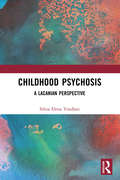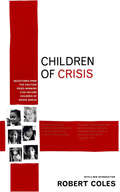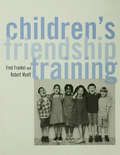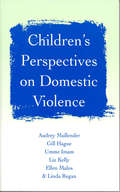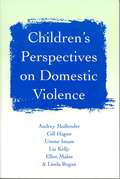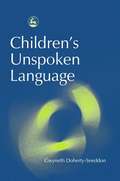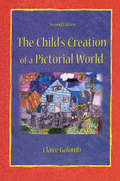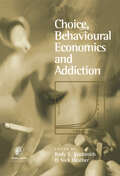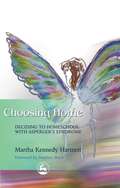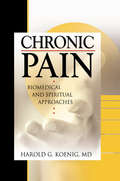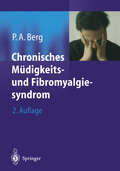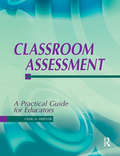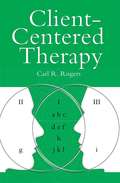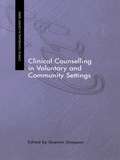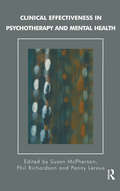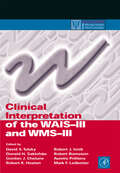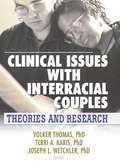- Table View
- List View
Childhood Psychosis: A Lacanian Perspective
by Silvia Elena TendlarzThis book, focusing on the work of Jacques Lacan, examines psychosis in children, without ignoring the study of neurosis in childhood and concentrates on autism as produced by psychic disorders, by the symbolic failure that brings about the inclusion of the subject into the psychotic structure.
Children of Crisis
by Robert ColesIn the 1950s Robert Coles began studying, living among, and, above all, listening to American children. The results of his efforts -- revealed in five volumes published between 1967 and 1977 -- constitute one of the most searching and vigorous social studies ever undertaken by one person in the United States. Here, heard often in their own voices, are America's "children of crisis": African American children caught in the throes of the South's racial integration; The children of impoverished migrant workers in Appalachia; Children whose families were transformed by the migration from South to North, from rural to urban communities; Latino, Native American, and Eskimo children in the poorest communities of the American West; The children of America's wealthiest families confronting the burden of their own privilege. This volume restores to print a masterwork of psychological and sociological inquiry -- a book that, in its focus on how children learn and develop in the face of rapid change and social upheaval, speaks directly and pointedly to our own times.
Children's Friendship Training
by Fred D. Frankel Robert J. MyattFirst published in 2003. Routledge is an imprint of Taylor & Francis, an informa company.
Children's Friendship Training
by Fred D. Frankel Robert J. MyattFirst published in 2003. Routledge is an imprint of Taylor & Francis, an informa company.
Children's Perspectives on Domestic Violence
by Gill Hague Linda Regan Ms Ellen Malos Ms Liz Kelly Ms Umme F Imam Professor Audrey Mullender`The research methodology and the problems encountered when studying a subject such as domestic violence, coupled with the ethical problems of researching with children, are discussed at length in the book. This gives a good insight into the intricacies of conducting such a research study. The research looked not only at children who were known to have direct contact with domestic violence, but also what children in general thought and felt about domestic violence. The presentation of the findings, both in tabular and narrative form, was well presented' - Accident and Emergency Nursing Journal `This book offers accessible and interesting reading. It is well written as one would expect from these authors.... There are a lot of pointers for the way forward in terms of both policy and practice. This is likely to become a seminal text' - Research Policy and Planning 'This is a useful and challenging read for all of us who seek to work effectively and ethically in this complex area of practice' - Professional Social Work `Just looking at the authors of this book tells the reader that they are about to embark on a pioneering piece of academic research... a comprehensive and authoritative piece of work' - Domestic Abuse Quarterly `A vital tool for all those working with children' - ChildRight 'Written in a lucid style and is easy to read… it is essential reading for all students in social work undergraduate courses and also in post-qualifying courses on child welfare and protection. In addition professionals who are directly working in the area of child protection, schools and criminal justice settings would find this book informative and useful in understanding what children and young people want, and need, in relation to living in domestic violence situations' - Child and Family Social Work 'This book is powerfully written and is essential reading for professional working with and supporting abused women and their children. Its groundbreaking focus on children's experiences adds much to our understanding of the complexities of domestic violence' - Journal of Family Studies 'A treasure-chest of rich, diverse and powerful extracts from children and young people… in particular the material presented on different coping strategies used by children who have experienced domestic violence is an important contribution to an area about which very little is known' - Adoption and Fostering Journal How do children who live with domestic violence cope? How do they make sense of their experiences? Do they receive the right sort of help from formal and informal sources? Drawing on the newest research designed to hear the voices of children and young people, this important book examines children's experiences and perspectives on living with domestic violence. The authors explore: - the effect of domestic violence on children - what children say would help them most in coping with domestic violence - the advice children would offer other children who find themselves in similar circumstances, their mothers and the helping professions. This accessible book written for students, their teachers, researchers and all those working with children - across social work, health, child psychology and psychiatry, the law and education - will provide a vital insight into children's own perspectives on domestic violence.
Children's Perspectives on Domestic Violence (PDF)
by Linda Regan Gill Hague Ms Ellen Malos Ms Liz Kelly Ms Umme F Imam Professor Audrey Mullender`The research methodology and the problems encountered when studying a subject such as domestic violence, coupled with the ethical problems of researching with children, are discussed at length in the book. This gives a good insight into the intricacies of conducting such a research study. The research looked not only at children who were known to have direct contact with domestic violence, but also what children in general thought and felt about domestic violence. The presentation of the findings, both in tabular and narrative form, was well presented' - Accident and Emergency Nursing Journal `This book offers accessible and interesting reading. It is well written as one would expect from these authors. . . . There are a lot of pointers for the way forward in terms of both policy and practice. This is likely to become a seminal text' - Research Policy and Planning 'This is a useful and challenging read for all of us who seek to work effectively and ethically in this complex area of practice' - Professional Social Work `Just looking at the authors of this book tells the reader that they are about to embark on a pioneering piece of academic research. . . a comprehensive and authoritative piece of work' - Domestic Abuse Quarterly `A vital tool for all those working with children' - ChildRight 'Written in a lucid style and is easy to read. . . it is essential reading for all students in social work undergraduate courses and also in post-qualifying courses on child welfare and protection. In addition professionals who are directly working in the area of child protection, schools and criminal justice settings would find this book informative and useful in understanding what children and young people want, and need, in relation to living in domestic violence situations' - Child and Family Social Work 'This book is powerfully written and is essential reading for professional working with and supporting abused women and their children. Its groundbreaking focus on children's experiences adds much to our understanding of the complexities of domestic violence' - Journal of Family Studies 'A treasure-chest of rich, diverse and powerful extracts from children and young people. . . in particular the material presented on different coping strategies used by children who have experienced domestic violence is an important contribution to an area about which very little is known' - Adoption and Fostering Journal How do children who live with domestic violence cope? How do they make sense of their experiences? Do they receive the right sort of help from formal and informal sources? Drawing on the newest research designed to hear the voices of children and young people, this important book examines children's experiences and perspectives on living with domestic violence. The authors explore: - the effect of domestic violence on children - what children say would help them most in coping with domestic violence - the advice children would offer other children who find themselves in similar circumstances, their mothers and the helping professions. This accessible book written for students, their teachers, researchers and all those working with children - across social work, health, child psychology and psychiatry, the law and education - will provide a vital insight into children's own perspectives on domestic violence.
Children's Unspoken Language
by Gwyneth Doherty-SneddonGwyneth Doherty-Sneddon, a developmental psychologist and the mother of two young children, demonstrates the way in which a young child's developing personality and intelligence is revealed through non-verbal communication. She shows how parents and other adults have the potential to facilitate a child's social and intellectual growth through acknowledging and responding to this unspoken language. Taking an in-depth look at four of the channels of non-verbal communication - hand gesture, facial expression, eye gaze and touch - this accessible text follows the development of young children from birth to late primary school age. Using jargon-free language Children's Unspoken Language is invaluable reading for parents and professionals alike.
Children's Unspoken Language (PDF)
by Gwyneth Doherty-SneddonGwyneth Doherty-Sneddon, a developmental psychologist and the mother of two young children, demonstrates the way in which a young child's developing personality and intelligence is revealed through non-verbal communication. She shows how parents and other adults have the potential to facilitate a child's social and intellectual growth through acknowledging and responding to this unspoken language. Taking an in-depth look at four of the channels of non-verbal communication - hand gesture, facial expression, eye gaze and touch - this accessible text follows the development of young children from birth to late primary school age. Using jargon-free language Children's Unspoken Language is invaluable reading for parents and professionals alike.
The Child's Creation of A Pictorial World
by Claire GolombThis book places child art within the broader context of children's creative intelligence and intrinsic motivation to invent a pictorial world. It examines the development of drawing and painting from several currently dominant theoretical perspectives. This is followed by an extensive examination of empirical data on the art work of children who are ordinary, talented, emotionally disturbed, and atypically developed due to mental disability or autism. The Child's Creation of a Pictorial World uses a developmental framework that combines theoretical sophistication with rigorous empirical investigations into the mental processes that underlie the child's drawings. It delineates the evolution of forms, the pictorial differentiation of figures and their spatial relations, the role of color in narrative descriptions, and its expressive function. Artistic development across all these dimensions is seen as a meaningful mental activity that serves cognitive, affective, and aesthetic functions.
The Child's Creation of A Pictorial World
by Claire GolombThis book places child art within the broader context of children's creative intelligence and intrinsic motivation to invent a pictorial world. It examines the development of drawing and painting from several currently dominant theoretical perspectives. This is followed by an extensive examination of empirical data on the art work of children who are ordinary, talented, emotionally disturbed, and atypically developed due to mental disability or autism. The Child's Creation of a Pictorial World uses a developmental framework that combines theoretical sophistication with rigorous empirical investigations into the mental processes that underlie the child's drawings. It delineates the evolution of forms, the pictorial differentiation of figures and their spatial relations, the role of color in narrative descriptions, and its expressive function. Artistic development across all these dimensions is seen as a meaningful mental activity that serves cognitive, affective, and aesthetic functions.
Choice, Behavioural Economics and Addiction
by Nick Heather Rudy E. VuchinichChoice, Behavioural Economics and Addiction is about the theory, data, and applied implications of choice-based models of substance use and addiction. The distinction between substance use and addiction is important, because many individuals use substances but are not also addicted to them. The behavioural economic perspective has made contributions to the analysis of both of these phenomena and, while the major focus of the book is on theories of addiction, it is necessary also to consider the behavioural economic account of substance use in order to place the theories in their proper context and provide full coverage of the contribution of behavioural economics to this field of study. The book discusses the four major theories of addiction that have been developed in the area of economic science/behavioural economics. They are:• hyperbolic discounting• melioration• relative addiction• rational addiction The main objective of the book is to popularise these ideas among addiction researchers, academics and practitioners. The specific aims are to articulate the shared and distinctive elements of these four theories, to present and discuss the latest empirical work on substance abuse and addiction that is being conducted in this area, and to articulate a range of applied implications of this body of work for clinical, public health and public policy initiatives. The book is based on an invitation-only conference entitled, Choice, Behavioural Economics and Addiction: Theory, Evidence and Applications held at the University of Alabama at Birmingham, March 30 - April 1, 2001. The conference was attended by prominent scientists and scholars, representing a range of disciplines concerned with theories of addiction and their consequences for policy and practice. The papers in the book are based on the papers given at the above conference, together with commentaries by distinguished experts and, in many cases, replies to these comments by the presenters.
Choosing Home: Deciding to Homeschool with Asperger's Syndrome (PDF)
by Martha Hartnett Stephen ShoreMartha Kennedy Hartnett is the mother of a child with Asperger's Syndrome who made the courageous choice to homeschool. Emerging from the author's personal experience, this book is a step by step account of successful home education. Choosing Home will take you into the homes of Asperger families as they journey from survival of the playground bully to making it work at home. Hartnett embraces those pertinent questions raised by parents: Will I be limiting my child's emotional and social development? How will I know if my teaching is good enough? What if I can't cope? These questions and many more are answered in this touching and insightful narrative. This is a book of hope and encouragement to all parents with an interest in homeschooling.
Chronic Pain: Biomedical and Spiritual Approaches
by Harold G KoenigHelp your clients achieve victory over chronic pain and lead more fulfilling lives!This insightful and informative book will help you deliver better pain management services to the people you care for. Incorporating biomedical, surgical, psychological, social, and spiritual perspectives, it provides vital, up-to-date information about how to reduce physical pain and explores techniques for improving people&’s ability to cope with it. Helpful tables provide easy access to information on medications for pain and managing side effects.Chronic Pain: Biomedical and Spiritual Approaches is filled with resources for the person in pain and for the health or religious professionals working to help them. It gives you very specific suggestions on how to manage chronic pain, including detailed information about medications, alternative therapies, psychological treatments, and spiritual strategies for pain management. The book is completed by two thoughtful appendixes: one examining pain medications and ways to manage their side effects and the other providing scriptural passages that can comfort those in pain.In addition to his experiences treating patients with chronic pain, the author suffers from chronic pain and disability himself. In this very personal book, he explores ways to help people coping with: low back pain fibromyalgia rheumatologic pain headaches the pain of multiple sclerosis other types of chronic unrelenting painChronic Pain: Biomedical and Spiritual Approaches can help people in pain and their families by showing them how to lead satisfying, joy-filled lives--whether their pain goes away or not. It is an essential reference book for everyone who works with pain sufferers as well as patients and their families!
Chronic Pain: Biomedical and Spiritual Approaches
by Harold G KoenigHelp your clients achieve victory over chronic pain and lead more fulfilling lives!This insightful and informative book will help you deliver better pain management services to the people you care for. Incorporating biomedical, surgical, psychological, social, and spiritual perspectives, it provides vital, up-to-date information about how to reduce physical pain and explores techniques for improving people&’s ability to cope with it. Helpful tables provide easy access to information on medications for pain and managing side effects.Chronic Pain: Biomedical and Spiritual Approaches is filled with resources for the person in pain and for the health or religious professionals working to help them. It gives you very specific suggestions on how to manage chronic pain, including detailed information about medications, alternative therapies, psychological treatments, and spiritual strategies for pain management. The book is completed by two thoughtful appendixes: one examining pain medications and ways to manage their side effects and the other providing scriptural passages that can comfort those in pain.In addition to his experiences treating patients with chronic pain, the author suffers from chronic pain and disability himself. In this very personal book, he explores ways to help people coping with: low back pain fibromyalgia rheumatologic pain headaches the pain of multiple sclerosis other types of chronic unrelenting painChronic Pain: Biomedical and Spiritual Approaches can help people in pain and their families by showing them how to lead satisfying, joy-filled lives--whether their pain goes away or not. It is an essential reference book for everyone who works with pain sufferers as well as patients and their families!
Classroom Assessment: A Practical Guide for Educators
by Dr Craig Mertler• Provides detailed information on· the functions of assessment;· how to construct, administer, and interpret the results of teacher-developed assessment techniques; and· how to interpret the results of externally developed instruments such as standardized tests.• Both traditional and newer, alternative assessment techniques are covered.• Advantages and disadvantages of each assessment technique are discussed.• A companion website helps both instructors and students obtain additional information on topics of special interest to them.• Numerous examples of the principles and procedures make it easy for students to understand the material.• The highly practical nature of this book stems from the focus on how assessment intertwines with other everyday activities in classrooms.• Measurement theory and computational procedures that are unlikely to be used by classroom teachers are de-emphasized, producing a textbook that provides comprehensive coverage without being unnecessarily technical.
Classroom Assessment: A Practical Guide for Educators
by Dr Craig Mertler• Provides detailed information on· the functions of assessment;· how to construct, administer, and interpret the results of teacher-developed assessment techniques; and· how to interpret the results of externally developed instruments such as standardized tests.• Both traditional and newer, alternative assessment techniques are covered.• Advantages and disadvantages of each assessment technique are discussed.• A companion website helps both instructors and students obtain additional information on topics of special interest to them.• Numerous examples of the principles and procedures make it easy for students to understand the material.• The highly practical nature of this book stems from the focus on how assessment intertwines with other everyday activities in classrooms.• Measurement theory and computational procedures that are unlikely to be used by classroom teachers are de-emphasized, producing a textbook that provides comprehensive coverage without being unnecessarily technical.
Client Centred Therapy (Psychology/self-help Ser.)
by Carl RogersPresenting the non-directive and related points of view in counselling and therapy, this book defines the progress recently made in the development of the techniques and basic philosophy of counselling.
Clinical Counselling in Voluntary and Community Settings (Clinical Counselling in Context)
by Quentin StimpsonClinical Counselling in Community and Voluntary Settings provides an overview of the development of counselling in a world of managed care, where resources are tight and professionals are stretched to their limits. Experienced contributors from a varied and diverse background cover issues including:* the place of community and voluntary organisations in society at large* the nature of counselling in voluntary and community settings* containment and holding* the nature of the client group and its affect on clinical workThis book will provide theoretical and practical advice of interest to both experienced practitioners and students considering a placement with a voluntary counselling organisation.
Clinical Counselling in Voluntary and Community Settings (Clinical Counselling in Context)
by Quentin StimpsonClinical Counselling in Community and Voluntary Settings provides an overview of the development of counselling in a world of managed care, where resources are tight and professionals are stretched to their limits. Experienced contributors from a varied and diverse background cover issues including:* the place of community and voluntary organisations in society at large* the nature of counselling in voluntary and community settings* containment and holding* the nature of the client group and its affect on clinical workThis book will provide theoretical and practical advice of interest to both experienced practitioners and students considering a placement with a voluntary counselling organisation.
Clinical Effectiveness in Psychotherapy and Mental Health: Strategies and Resources for the Effective Clinical Governance
by Phil Richardson Susan McPherson Penny LerouxIn this volume, the editors examine the state of clinical governance in the Mental Health sector. Despite the often confusing wealth of literature on the subject, little, if any, refers specifically to psychological treatment services. Clinical Effectiveness in Psychotherapy and Mental Health provides a guide to learning about the different guidelines and evaluation methods. It focuses on three important contributions to clinically effective practice: clinical audit, outcome monitoring and evidence-based practice.
Clinical Effectiveness in Psychotherapy and Mental Health: Strategies and Resources for the Effective Clinical Governance
by Phil Richardson Susan McPherson Penny LerouxIn this volume, the editors examine the state of clinical governance in the Mental Health sector. Despite the often confusing wealth of literature on the subject, little, if any, refers specifically to psychological treatment services. Clinical Effectiveness in Psychotherapy and Mental Health provides a guide to learning about the different guidelines and evaluation methods. It focuses on three important contributions to clinically effective practice: clinical audit, outcome monitoring and evidence-based practice.
Clinical Interpretation of the WAIS-III and WMS-III (ISSN)
by David S. Tulsky Donald H. Saklofske Gordon J. Chelune Robert K. Heaton Robert J. Ivnik Robert Bornstein Aurelio Prifitera Mark F. LedbetterThis guide to the WAIS-III and WMS-III tests is written to help clinical practitioners achieve efficient and accurate interpretations of test results. The only interpretive guide to be based on data obtained while standardizing the tests, this reference source provides new models for interpreting results, as well as practical information on the diagnostic validity, demographically corrected norms, and accuracy of the tests in measuring intelligence and memory. The focus of information is to allow clinicians to reduce variance in the interpretations of scores, indicating how best to factor in socio-economic status of respondents, interpreting meaningful change in serial assessments, and scoring with alternate or omitted sub-tests. Also included in the book are chapters on accommodating clients with disabilities. The final chapter discusses frequently asked questions (with answers) on the use and interpretation of the tests, as well as practical issues to help make scoring time-efficient and accurate. Only guide to be based on data obtained in the standardization of the tests Practical examples given to help guide interpretation of scores Focuses on information to make faster, more accurate scoring interpretations
Clinical Issues with Interracial Couples: Theories and Research
by Volker Thomas Joseph L. Wetchler Terri KarisGo beyond cookie-cutter therapy and interventions to provide culturally relevant therapy that works for your clients in interracial relationships! With this book, you'll explore an array of relational issues faced by various configurations of interracial couples. Then you'll learn specific intervention strategies for treating these couples in therapy. The first section presents research and theoretical chapters on issues faced by interracial couples who are heterosexual; the second focuses on issues facing racially mixed gay and lesbian couples; and the third provides you with specific interventions to use with couples in interracial relationships. Clinical Issues with Interracial Couples: Theories and Research is an important addition to the collection of any therapist who counts an interracial couple among his or her clients. From the editors: "Although interracial couples face challenges related to differences in their racial backgrounds, couple and family theories have had little to say about how to work with these differences. Not all couples are white, married, and heterosexual, and there is a growing understanding that clinical practices based on these assumptions may not be adequate when working with interracial couples. Recognizing the diversity of our clients, the intent of this book is to contribute to more respectful and inclusive clinical practices that can address the treatment issues we face in the first decade of the twenty-first century." The first section of this book examines challenges faced by heterosexual interracial couples, focusing on: how black/white couples experience and respond to racism and how they negotiate the racial and ethnic differences they face in their relationships the significance of race-or lack of it-in white women's relationships with black men, with suggestions on how to create a therapeutic space for discussing race without over-determining its significance marriages where one partner is of Latino/a descent and the other of non-Latino/a white descent-a pilot study of a rarely investigated population! approaches, interventions, and strategies to use when treating multicultural Muslim couples Hawaii's unusual history of interracial ties and relationships, the common challenges that face interracial couples there, and therapeutic interventions that can benefit them The second section of Clinical Issues with Interracial Couples looks at the issues faced by same-sex interracial couples. Here is a sample of what you'll find: clinical considerations for working with interracial/intercultural lesbian couples pitfalls to avoid in therapy as well as suggestions for a conceptual approach for gay Latino men in cross-cultural relationships The book's final section presents interventions for use with interracial couples. Here you'll find: assessment techniques and interventions geared toward black-white couples information on doing effective therapy with Latino/a-white couples a case study of the therapeutic process as applied to an Asian-American woman married to a white man seven therapists' perspectives on working with interracial couples-focusing on the historical context of intermarriage, specific concerns and issues that interracial couples experience in their relationships, and the experiences of therapists working with this diverse and challenging client population
Clinical Issues with Interracial Couples: Theories and Research
by Volker Thomas Joseph L. Wetchler Terri KarisGo beyond cookie-cutter therapy and interventions to provide culturally relevant therapy that works for your clients in interracial relationships! With this book, you'll explore an array of relational issues faced by various configurations of interracial couples. Then you'll learn specific intervention strategies for treating these couples in therapy. The first section presents research and theoretical chapters on issues faced by interracial couples who are heterosexual; the second focuses on issues facing racially mixed gay and lesbian couples; and the third provides you with specific interventions to use with couples in interracial relationships. Clinical Issues with Interracial Couples: Theories and Research is an important addition to the collection of any therapist who counts an interracial couple among his or her clients. From the editors: "Although interracial couples face challenges related to differences in their racial backgrounds, couple and family theories have had little to say about how to work with these differences. Not all couples are white, married, and heterosexual, and there is a growing understanding that clinical practices based on these assumptions may not be adequate when working with interracial couples. Recognizing the diversity of our clients, the intent of this book is to contribute to more respectful and inclusive clinical practices that can address the treatment issues we face in the first decade of the twenty-first century." The first section of this book examines challenges faced by heterosexual interracial couples, focusing on: how black/white couples experience and respond to racism and how they negotiate the racial and ethnic differences they face in their relationships the significance of race-or lack of it-in white women's relationships with black men, with suggestions on how to create a therapeutic space for discussing race without over-determining its significance marriages where one partner is of Latino/a descent and the other of non-Latino/a white descent-a pilot study of a rarely investigated population! approaches, interventions, and strategies to use when treating multicultural Muslim couples Hawaii's unusual history of interracial ties and relationships, the common challenges that face interracial couples there, and therapeutic interventions that can benefit them The second section of Clinical Issues with Interracial Couples looks at the issues faced by same-sex interracial couples. Here is a sample of what you'll find: clinical considerations for working with interracial/intercultural lesbian couples pitfalls to avoid in therapy as well as suggestions for a conceptual approach for gay Latino men in cross-cultural relationships The book's final section presents interventions for use with interracial couples. Here you'll find: assessment techniques and interventions geared toward black-white couples information on doing effective therapy with Latino/a-white couples a case study of the therapeutic process as applied to an Asian-American woman married to a white man seven therapists' perspectives on working with interracial couples-focusing on the historical context of intermarriage, specific concerns and issues that interracial couples experience in their relationships, and the experiences of therapists working with this diverse and challenging client population
